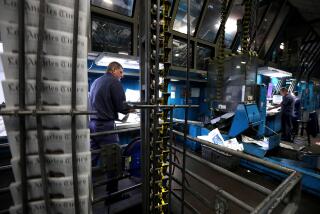GM’s Famed, Old Fisher Body Plant Is Slowly Fading Into Auto History
- Share via
FLINT, Mich. — From the office where General Motors Corp. founder William Durant sat when he opened a plant for his last car company in 1921, Bob Hameister guides the factory’s daily operations--and prepares for its demise.
Little more than a year after Hameister took over as manager of the Fisher Body plant, GM announced it would close the facility, which it had bought in 1925 and turned into the world’s largest body-only plant.
That was four years ago. In that time, Hameister had to keep his plant running at constantly improving efficiency and quality while he prepared his workers for the closing, now set for December.
Since the 1983 announcement, the plant has been granted three extensions and its name has been changed to Flint Body. But last November, GM announced that it will close nine plants and parts of two others in the next three years, and Flint Body was among them.
“This has been the longest plant closing in history,” Hameister said.
The demise of Flint Body, one of only two GM body-only plants, was dictated by the renovation of a nearby Buick complex into the all-in-one Buick City plant, which makes its own bodies.
Too Late to Rescue
Hameister and United Auto Workers union officials have found themselves on the leading edge of the evolution in labor relations at GM, which has saved other plants but can’t rescue this one.
“If we would have started joint meetings 10 years ago to address problems then we’d be increasing volume now instead of decreasing it,” said Al Yelle, shop committee chairman for UAW Local 581.
Durant, a carriage maker, took control of Buick Manufacturing Co. in 1904 and incorporated General Motors Co. in 1908, bringing in the Olds and Cadillac companies before he lost control in 1910. He regained control of GM in 1916, added Chevrolet in 1918, and was forced to resign in 1920. In 1921, he founded Durant Motors Inc., which eventually failed.
Hameister has decided that Durant’s original office desk and chairs will be donated to the restoration of a Flint office building Durant once shared with Charles Nash, a one-time GM president and founder of an auto company bearing his name.
He is less sure about what will happen to the plant’s 3,200 remaining hourly and salaried workers, most of whom have little chance of finding a GM job.
Jobs Outlook Dim
About 2,800 of GM’s 55,000 Flint-area workers already are on indefinite layoff, and 3,000 more will be added before Flint Body closes, Yelle said. And GM plants are closing across the country.
“We’ve got to guide them through this. It’s going to be very traumatic for everyone,” said Hameister, who says he has no idea what he’ll do after the plant closes.
“I think many of them understand that at least in the immediate future there is not going to be a job. Between now and the time the plant closes, we’ve got to make sure they are physically and mentally able to handle the change in their life styles.”
The company and union are providing education and retraining for jobs outside GM, both in the plant and through tuition reimbursements.
There’s a joint union-management career development center, and a communications center controls rumors and answers questions from workers and their families. A daily newsletter and closed-circuit television keep workers informed on plant performance, benefits, training courses and meetings.
“You can’t over-communicate,” Hameister said.
And during the intermittent periods when Flint Body is shut down, Hameister lends workers to other GM plants so they can demonstrate their abilities and perhaps get a job.
“We have a unique role and defined obligation--one, to find work for our people and two, to help people manage the stress inherent in the situation we’re all in,” he said in a recent interview.
At the same time, “we’ve got to run the business like we’re going to be here for the next 50 years.”
More to Read
Inside the business of entertainment
The Wide Shot brings you news, analysis and insights on everything from streaming wars to production — and what it all means for the future.
You may occasionally receive promotional content from the Los Angeles Times.










